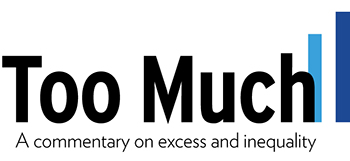A noted World Bank economist is suggesting we need to concentrate less on the complexities of high finance and more on the noxious simplicity of our deeply unequal income distribution.
By Sam Pizzigati
Our high priests of high finance — the bankers and traders of Wall Street — take great pride in the complexity of their endeavors. Single-tranche collateralized debt obligations. Contingent conversion triggers. Credit default swaps. Incantations like these leave most of us bewildered. Not them. They understand. And they deserve, the argument goes, all the big bucks this understanding may bring.
At AIG, we learned Tuesday, this understanding brought $454 million in “performance” bonuses to the company’s power suits last year — on top of the $165 million in post-bailout bonuses that we already knew about.
AIG set aside still another $1 billion for “retention payments.” The company, we’re assured, had no choice. It could not afford to lose people who understand the “complexity” of AIG’s business.
The well-intentioned journalists and academics who’ve tried to explain just how this business drove the global economy over the cliff have not for the most part, unfortunately, been able to escape this complexity.
To understand what has gone so horribly wrong with our economy, these analysts inform us, we need to train our brains on the complexities of contemporary high finance — and how Wall Street so recklessly manipulated them.
The end result of all this concentration on complexity? Most Americans remain utterly bewildered about exactly what caused our current crisis and what we need to do to end it.
Enter Branko Milanovic. A lead economist at the World Bank, an expert on financial globalization, Milanovic can do complexity as well as anybody. But he chooses not to. In a just-published manifesto, he’s urging the rest of us to junk the concentration on complexity, too — and focus instead on one simple phenomenon we can all understand. That phenomenon: inequality.
We won’t find the real cause of our current economic meltdown, Milanovic argues, in “the arcane of how ‘derivatives’ work.” That real cause “lies in huge inequalities in income distribution.”
Yes, Milanovic readily acknowledges in the latest edition of the Yale Center for the Study of Globalization flagship economic review, financial manipulations have certainly done our body politic grievous harm. But explanations of our current predicament that focus on “feckless bankers, financial deregulation, crony capitalism, and the like” overlook our far more fundamental problem, our increasingly unequal distribution of income “across individuals and social classes.”
Milanovic has spent a good chunk of his professional career tracking this rising inequality. In the United States, he notes, our most affluent 1 percent have doubled their share of the national income since 1976 and, in the process, “eerily replicated the situation that existed just prior to the crash of 1929.”
What makes rising inequality so toxic to our economic health? In any society growing wildly unequal, Milanovic explains, the rich can only physically consume just so much of their new-found fortune. Life simply limits how many “Dom Pérignons and Armani suits one can drink or wear.”
That reality lives the rich sitting on “a huge pool of available financial capital,” hankering for profitable investment opportunities. They need help putting their excess cash to work. They ask their friends in high finance for it.
But these friends — investment bankers, hedge fund managers, and assorted other financial wizards — quickly become overwhelmed. In a top-heavy society, with wealth packed in precious few pockets, financial movers and shakers simply can’t find enough “safe and profitable investment opportunities” to handle the enormous quantities of cash at their disposal.
What do these financial wizards do? They’re certainly not going to walk away from all those astounding investment fees they can charge their wealthy clients. So they take their only other alternative. They steer the wealth of the wealthy into unsafe investments. They invent ever more exotic securities. They endlessly repackage high-interest loans to borrowers at high risk of default.
In the end, observes Milanovic, Wall Street’s kings of complexity would create a financial system that boiled down to “basically throwing money at anyone who would take it.”
But this recklessness could only get traction in a society where large numbers of people felt they had to borrow, at any terms lenders demand. In the United States, over recent years, large numbers of Americans felt just this way. Rising inequality left them little choice.
Real median wages in the United States, Milanovic details, have been “stagnant” for the past 25 years, “despite an almost doubling of GDP per capita.” The gains from America’s economic growth have gone overwhelmingly to the top. Between 1976 and 2006, he notes, the nation’s richest 5 percent pocketed nearly “one-half of all real income gains.”
To chase the American Dream, amid this inequality, average Americans had to borrow — and keep borrowing. Household debt in the United States quickly soared from “48 percent of GDP in the early 1980s to 100 percent of GDP before the crisis.”
That crisis came — the entire financial system collapsed — when great numbers of middle class Americans began defaulting on their debts, as they inevitably would in a society where income was furiously concentrating not at the middle of the economic ladder but at the top.
A simple story to understand. And the key to recovery? That’s equally simple. Rising inequality created the crisis. More equality, Branko Milanovic’s work suggests, will end it.
Sam Pizzigati edits Too Much, the online weekly on excess and inequality.



Discussion
No comments for “Did Derivatives Drive the Meltdown?”